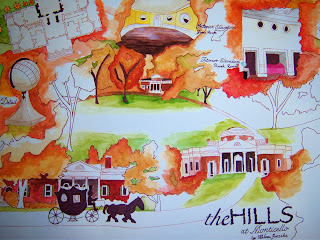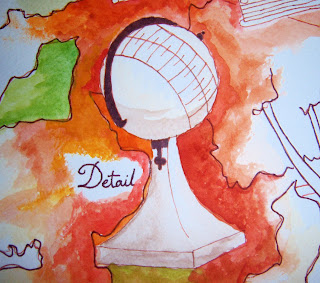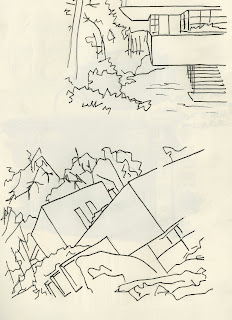
Jefferson's private bedroom is rooted in French design. (Above)
Roots. The basic cause, source, or origin of something. When visiting Monticello, we learned that the roots of Jefferson's home came from his travels and experiences from all over the world. Jefferson spent a great deal of time in France as the U.S. Ambassador. He studied the architecture of that country and brought it back to help build his home. "Gothic architecture, with its roots in northern European sources, evoked an uncivilized brutish period that they began to call the dark age that separated the glories of ancient Greece and Rome from their own time" (Roth 317). The following quotation further explains the idea one having roots, or borrowing, basic ideas from one source and branching off of that to create their own ideas.

My released explosion of drawings for Suzanne
(not finished yet but is turning out to be one of my favorite project).
It's refreshing to get assigned something thats just really fun
when you're stressed out off your mind yo !! (Above)
Compression / Release. To flatten by pressure and then to allow to escape from confinement. With our latest assignment in Suzanne's class, we were told to draw at least five pictures all on one sheet of paper. Many of our other projects have been to only draw one picture on a piece of paper, which makes the assignment feel very compressed. Our new project is releasing and allows us to have an explosion of drawings. "In fact, if it were possible to freeze that form and invert it, the result would be a catenary curve or parabolic arch virtually entirely in compression" (Roth 38). This quote further explains the idea of compression holding something in. "Exposed to red, for example, the body experiences an increase in muscular tension, the release of adrenalin, increase of the heartbeat, and a stepping-up of gastric activity" (Roth 76). This quote explains the idea of releasing tension, much like I did for Suzanne's assignment.

Plan view of Jefferson's Monticello. Though, not completely
identical, Monticello is extremely congruent and balanced. (Above)
Congruence. In agreement or harmony. At Monticello, Jefferson created a very congruent plan for his foundation. When viewing the home it appears to be a symmetric space. Each side of the house is almost identical to the other, which gives the house it's congruent appearance. "The technique of fan vaulting was used here at its grandest scale; the walls are completely dissolved in glass, and the vaults, windows, and detailing are a complete harmony" (Roth 310). Congruency is another form of harmony, which gives a space a sense of meaning and consistency.

Jefferson's spherical sundial. Get it young J !! (Above)
Materiality. The quality or character of being material or composed of matter. In Monticello, Jefferson used all local materials to build his home. He used lumber, brick, and other various materials from the surrounding towns. Jefferson also created a lot of material objects for his home, including a spherical sun dial that he designed himself.

Monticello set a top a hill, my inspiration and concept
for my composition board. (Above)
Concept. An abstract idea; a general notion. In Suzanne's drawing class, I was assigned a project were I had to draw a series of picture on Monticello. My concept for the graphic was "The Hill." At Monticello, the house was surrounded by hundreds of hills and Jefferson actually had the top of a hill removed so that he could build his home there. "It was from Behrens that Mies derived the concept of the artist as agent of the taste of the age, and of architecture as being an expression of technical power" (Roth 469). Roth explains the idea of concept, by discussing the general notion of what an artist and architect is in an abstract way.
While I was working on Suzanne's assignment and looking at these opus words I easily found that Monticello applied to every word. The roots of Monticello originate from France. The house is extremely congruent and symmetrical. Jefferson also used only local materials to build his home. Monticello allowed me to create a released drawing rather than one that was compressed and made an easy concept for my overall composition.




